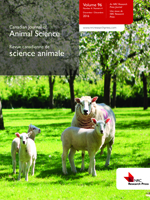Miller-Cushon, E. K. and DeVries, T. J. 2015. Invited review: Development and expression of dairy calf feeding behaviour. Can. J. Anim. Sci. 95: 341-350. Feeding and housing practices for dairy calves impact performance and growth early in life, as well as feeding behaviour. There is also increasing evidence that early exposure to different feeding and housing strategies influence the development of feeding behaviour. The dairy calf needs access to milk in sufficient quantities to maintain health and high-levels of growth. In addition, intake of solid feed, such as grain concentrate, is necessary early in life to establish fermentation and develop the rumen. In dairy calves, feeding behaviour patterns can have direct impact on nutrient consumption and, consequently, growth. Further, recent research has provided evidence that behaviour patterns that develop in response to management factors early in life may persist once learned, potentially having longer-term implications for health and welfare. Thus, there is potential for various nutritional, housing, and management factors to impact the learning of feeding behaviour early in the life of dairy calves. This review provides several examples of early management factors that influence feeding behaviour of dairy calves and, in turn, impact calf growth and welfare. For example, providing continuous, ad libitum access to milk results not only in greater growth, but also in meal patterns that more closely resemble the natural behaviour of a calf suckling its dam. Housing management also has the potential to influence when, and how much, a calf eats. Whereas social facilitation promotes intake, particularly at weaning, competition for feed in group-housed calves restricts feeding patterns and degree of feeding synchrony. With regards to provision of solid feed, recent data suggest that providing physically effective hay, in addition to grain concentrate, may be beneficial for the rumen environment and consequent growth and efficiency. However, the physical form and presentation of forage may also influence feeding behaviour of calves, in particular feed sorting, which can impact both immediate nutrient intakes as well as the development and persistence of that behaviour. For example, calves provided hay and concentrate as a mixture begin to sort their feed early in life, with the pattern of sorting depending on hay particle size. Feed sorting in young calves may reflect a motivation to consume a proportion of hay in the diet. In general, it appears to be beneficial for early growth and welfare to support milk and solid feed intake through unrestricted allowances and less-competitive feeding environments. Continued research in this area is needed to assess the longevity of learned behaviour patterns, and what factors may influence their persistence.
How to translate text using browser tools
11 May 2015
Invited review: Development and expression of dairy calf feeding behaviour
E. K. Miller-Cushon,
T. J. DeVries
ACCESS THE FULL ARTICLE
It is not available for individual sale.
This article is only available to subscribers.
It is not available for individual sale.
It is not available for individual sale.
alimentation
behaviour
comportement
dairy calf
feeding
veau laitier





